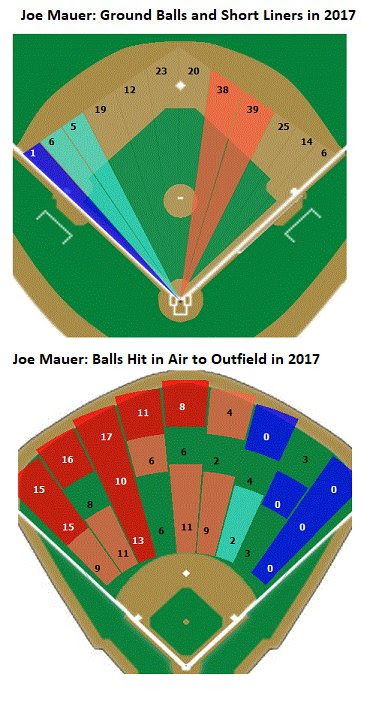Over the weekend there was a bit of hubbub about the Phillies’ use of seeminglyconflicting shifts in the infield and outfield in a Grapefruit League game against Twins first baseman Joe Mauer. Their infielders were playing Mauer in what BIS calls a Full Ted Williams Shift (three men on the pull side of the infield), while their outfielders were heavily shaded to the opposite field. This alignment could look perplexing if you assume that players hit balls the same direction whether in the air or on the ground. But the thing is, this makes some sense given Mauer’s tendencies, and he’s not unique in this respect.
The diagrams below (which we like to call "smart charts") show the number of balls hit to different areas of the field where the fielder can make a difference (i.e. no pop-ups for infielders or short line drives for outfielders). The color coding includes a weighting system that increases the importance placed on high-impact locations (down the line, deep, and in the gaps). Here we have Mauer’s batted ball breakdown on grounders and short line drives (GSLs) and outfield airballs from last season.

As it turns out, most players who are candidates for infield shifts (lefties that pull 75 percent of their GSLs and righties that pull 80 percent of their GSLs) have a much more balanced and at times opposite-field-heavy approach on balls to the outfield.
Of the 135 shift candidates with at least 300 at-bats in 2017, 78 of them pulled less than half of their outfield airballs (58 percent). To make the point a different way, 82 percent of hitters with at least 300 at-bats in 2017 (244 out of 296) pulled at least 70 percent of their GSLs, but none of them pulled at least 70 percent of their outfield airballs.
Mauer happens to be on the extreme end of this dichotomy, one of only a handful of players with such a starkly opposite batted-ball profile on the ground versus in the air. That said, he doesn’t represent such a unique profile that we should be surprised to see defenses like the one the Phillies employed (and others have employed in the past). We might see outfield shifts occur more often than ever this year, and the most effective ones will play the hitter to the opposite field.